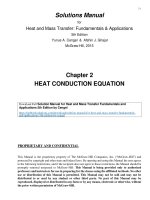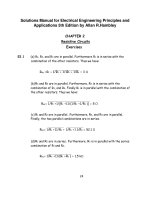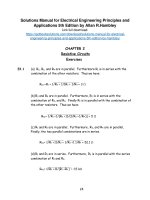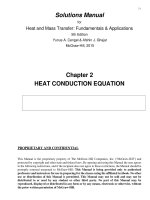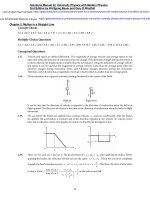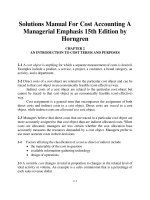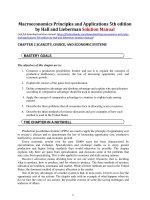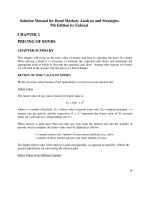Solutions manual for electrical engineering principles and applications 5th edition by hambley download
Bạn đang xem bản rút gọn của tài liệu. Xem và tải ngay bản đầy đủ của tài liệu tại đây (3.51 MB, 71 trang )
Solutions Manual for Electrical Engineering Principles and
Applications 5th Edition by Allan R.Hambley
CHAPTER 2
Resistive Circuits
Exercises
E2.1
(a) R2, R3, and R4 are in parallel. Furthermore R1 is in series with the
combination of the other resistors. Thus we have:
Req =R1 + 1/R2 + 1/1R3 + 1/R4 = 3 Ω
(b) R3 and R4 are in parallel. Furthermore, R2 is in series with the
combination of R3, and R4. Finally R1 is in parallel with the combination of
the other resistors. Thus we have:
Req= 1/R1 +1/[R2 +11/(1/R3 +1/R4 )] = 5 Ω
(c) R1 and R2 are in parallel. Furthermore, R3, and R4 are in parallel.
Finally, the two parallel combinations are in series.
Req= 1/R1 +11/R2 + 1/R3 +1 1/R4 = 52.1 Ω
(d) R1 and R2 are in series. Furthermore, R3 is in parallel with the series
combination of R1 and R2.
Req= 1/R3 +11/(R1 +R2 ) = 1.5 kΩ
24
E2.2
(a) First we combine R2, R3, and R4 in parallel. Then R1 is in series with
the parallel combination.
1
1/
20 V
20
Req = 1 /
= 10 9.231 =1.04 A
1 / =9 .231 Ω i 1 =
R 1 +Req
+
R 2+
R3 +
R4
veq=Reqi1 = 9.600 V i2 =veq/R2 = 0.480A i3 =veq/R3 = 0.320 A
i4 =veq/R4 = 0.240 A
(b) R1 and R2 are in series. Furthermore, R3, and R4 are in series. Finally,
the two series combinations are in parallel.
Req 1 =R 1 +R 2 =20 Ω Req 2 =R 3 +R 4 =20 Ω Req =
1
1 /Req 1 +1 /Req 2
=10 Ω
veq= 2×Req= 20 V i1 =veq/Req1 = 1A i2 =veq/Req2 = 1 A
(c) R3, and R4 are in series. The combination of R3 and R4 is in parallel
with R2. Finally the combination of R2, R3, and R4 is in series with R1.
25
R
eq 1
v
1
=20 Ω i = s
=1 A
=
4
eq 2
1
1 /Req 1 +1 /R 2
R 1 +Req 2
= 20 V i2 =v2 /R2 = 0.5A i3 =v2 /Req1 = 0.5 A
=R +R = 40 Ω R
3
v2 =i1Req2
R
R
E2.3 (a) v1 =vsR1 +R2 +1R3 +R4 = 10 V. v2 =vsR1 +R2 +2R3 +R4 = 20 V .
Similarly, we find v3 = 30Vand v4 = 60V.
(b) First combine R2 and R3 in parallel: Req= 1 (1/R2 +1R3) = 2.917 Ω.
Then we have v1 =vsR1 +R
R
1
eq
+R4 = 6.05 V. Similarly, we find
26
E2.4
(a)
First combine R1 and R2 in series: Req = R1 + R2 = 30 Ω. Then we
have i1 =isR3R+3Req= 1515+30 = 1 A and i3 =isR3R+eqReq= 1530+30 = 2 A.
(b)
The current division principle applies to two resistances in parallel.
Therefore, to determine i1, first combine R2 and R3 in parallel: Req =
R
5
eq
1/(1/R2 + 1/R3) = 5 Ω. Then we have i1 =isR1 + Req= 10 + 5 = 1 A .
Similarly, i2 = 1 A and i3 = 1 A.
E2.5
Write KVL for the loop consisting of v1, vy , and v2. The result is -v1 - vy +
v2 = 0 from which we obtain vy = v2 - v1. Similarly we obtain vz = v3 - v1.
E2.6
Node 1: v1 −1v3 +v1 −2v2 =ia
R
Node 2: v2R−2v1 +vR23 +v2R−4v3 = 0
R
Node 3: v3 +v3R−4v2 +v3R−1v1 +ib= 0
R5
E2.7
Following the step-by-step method in the book, we obtain
1+1
−1
R1 R 2
R2
0
v1
vv23
−R12 R12 +R13 +R14−R141
1
0
1
−
R4
is
R4 R5
27
i0s
E2.8
Instructions for various calculators vary. The MATLAB solution is given
in the book following this exercise.
eq
R
v2 =vsR
1
+Req+R4 =
5.88 Vand v4 = 8.07 V.
28
E2.9
(a) Writing the node equations we obtain:
Node 1: v1 −v3 +v
+v1 −v2 = 0
2010
Node 2: v2 −v1 +10 +v2 −v3 = 0
10
5
Node 3: v3 −v1 +v3 +v3 −v2 = 0
20
10
5
(b) Simplifying the equations we obtain:
0.35v1 − 0.10v2 − 0.05v3 = 0
− 0.10v1 + 0.30v2 − 0.20v3 =−10
− 0.05v1 − 0.20v2 + 0.35v3 = 0
(c) and (d) Solving using Matlab:
>>clear
>>G = [0.35 -0.1 -0.05; -0.10 0.30 -0.20; -0.05 -0.20 0.35];
>>I = [0; -10; 0];
>>V = G\I
V=
-27.2727
-72.7273
-45.4545
>>Ix = (V(1) - V(3))/20
Ix =
0.9091
E2.10 Using determinants we can solve for the unknown voltages as follows:
6 − 0.2
1 0.5
3+ 0.2
= 10.32 V
v1 = 0.7 − 0.2 = 0.35 − 0.04
− 0.2 0.5
0.7 6
29
0.7 +1.2
− 0.2 1
=
6.129 V
v2 = 0.7 − 0.2 = 0.35 − 0.04
− 0.2 0.5
Many other methods exist for solving linear equations.
E2.11 First write KCL equations at nodes 1 and 2:
Node 1: v1 −10
+v +v1 −v2 = 0
210
Node 2: v2 −10 +v2 +v2 −v1 = 0
10
5
10
Then, simplify the equations to obtain:
8v1 −v2 = 50 and −v1 + 4v2 = 10
Solving manually or with a calculator, we find v1 = 6.77 V and v2 = 4.19 V.
The MATLAB session using the symbolic approach is:
>> clear
[V1,V2] = solve('(V1-10)/2+(V1)/5 +(V1 - V2)/10 = 0' , ...
'(V2-10)/10 +V2/5 +(V2-V1)/10 = 0')
V1 =
210/31
V2 =
130/31
Next, we solve using the numerical approach.
>> clear
G = [8 -1; -1 4];
I = [50; 10];
V = G\I
V=
6.7742
4.1935
30
E2.12 The equation for the supernode enclosing the 15-V source is:
v3 −v2 +v3 −v1 =v1 +v2
R3
R1 R2 R4
This equation can be readily shown to be equivalent to Equation 2.37 in
the book. (Keep in mind that v3 = -15 V.)
E2.13 Write KVL from the reference to node 1 then through the 10-V source to
node 2 then back to the reference node:
−v1 +10 +v2 = 0
Then write KCL equations. First for a supernode enclosing the 10-V
source, we have:
v1 +v1 −v3 +v2 −v3 = 1
R1 R2
R3
Node 3:
v 3 +v 3 −v 1 +v 3 −v 2 = 0
R4 R2
Reference node:
R3
v1 +v3 = 1 R1 R4
An independent set consists of the KVL equation and any two of the KCL
equations.
E2.14
(a) Select the reference
node at the left-hand
end of the voltage
source as shown at right.
Then write a KCL
equation at node 1.
10
v1 +v1 −
+1 = 0
R1 R2
Substituting values for the resistances and solving, we find v1 = 3.33 V.
31
Then we have
ia =
10 −v
1
=1.333
A.
R2
(b) Select the
reference node and
assign node voltages as
shown.
Then write KCL
equations at nodes 1
and 2.
v1 −25 +v1 +v1 −v2 = 0
R2 R4 R3
v2 −25 +v2 −v1 +v2 = 0
R1
R3 R5
Substituting values for the resistances and solving, we find v1 = 13.79 V
and v
E2.15
2
v −v
= 18.97 V. Then we have ib= 1R
3
2
= -0.259 A.
(a)
Select the
reference node and
node voltage
as
shown. Then write a
KCL equation at node
1, resulting in
v
+v1 −5
10
−2ix= 0
Then use ix= (10 −v1)/5 to substitute and solve. We find v1 = 7.5 V.
Then we have ix=
10 −v
5
1
= 0.5 A.
(b) Choose the reference node and node voltages shown:
32
Then write KCL equations at nodes 1 and 2:
v +v
1
v 2 +v
−2iy+3 = 0
2
−2iy =
3
2
5
10
Finally use iy=v2 /5 to substitute and solve. This yields v2 = 11.54V and iy=
2.31 A.
E2.16 >> clear
>> [V1 V2 V3] = solve('V3/R4 + (V3 - V2)/R3 + (V3 - V1)/R1 = 0', ...
'V1/R2 + V3/R4 = Is', ...
'V1 = (1/2)*(V3 - V1) + V2' ,'V1','V2','V3');
>> pretty(V1), pretty(V2), pretty(V3)
R2 Is (2 R3 R1 + 3 R4 R1 + 2 R4 R3)
----------------------------------------------2 R3 R1 + 3 R4 R1 + 3 R1 R2 + 2 R4 R3 + 2 R3 R2
R2 Is (3 R3 R1 + 3 R4 R1 + 2 R4 R3)
----------------------------------------------2 R3 R1 + 3 R4 R1 + 3 R1 R2 + 2 R4 R3 + 2 R3 R2
Is R2 R4 (3 R1 + 2 R3)
----------------------------------------------33
2 R3 R1 + 3 R4 R1 + 3 R1 R2 + 2 R4 R3 + 2 R3 R2
E2.17 Refer to Figure 2.33b in the book. (a) Two mesh currents flow through
R2: i1 flows downward and i4 flows upward. Thus the current flowing in R2
referenced upward is i4 - i1. (b) Similarly, mesh current i1 flows to the
left through R4 and mesh current i2 flows to the right, so the total
current referenced to the right is i2 - i1. (c) Mesh current i3 flows
downward through R8 and mesh current i4 flows upward, so the total
current referenced downward is i3 - i4. (d) Finally, the total current
referenced upward through R8 is i4 - i3.
E2.18 Refer to Figure 2.33b in the book. Following each mesh current in turn, we
have
R1i1 +R2(i1 −i4 ) +R4 (i1 −i2) −vA= 0
R5i2 +R4 (i2 −i1) +R6(i2 −i3) = 0
R7i3 +R6(i3 −i2) +R8(i3 −i4 ) = 0
R3i4 +R2(i4 −i1) +R8(i4 −i3) = 0
In matrix form, these equations become
(R1 +R2 +R4)
−R0 4
−R4
0
i1
−R2
(R4 +−RR56+R6)(R6 +−RR76+R8)
vA
ii23
−0R8
=
00
−R2
0
−R
8
E2.19 We choose the mesh currents as shown:
34
(R+R+R) i4
2
3
8
0
Then, the mesh equations are:
5i1 +10(i1 −i2) = 100 and
10(i2 −i1) + 7i2 +3i2 = 0
Simplifying and solving these equations, we find that i1 = 10 A and i2 = 5
A. The net current flowing downward through the 10-Ω
resistance is i1 −i2 = 5 A.
To solve by node voltages, we select the reference node and node
voltage shown. (We do not need to assign a node voltage to the
connection between the 7-Ω resistance and the 3-Ω resistance because
we can treat the series combination as a single 10-Ω resistance.)
The node equation is (v1 −10)/5 +v1 /10 +v1 /10 = 0. Solving we find that v1
= 50 V. Thus we again find that the current through the 10-Ω
resistance is i=v1 /10 = 5A.
Combining resistances in series and parallel, we find that the resistance
“seen” by the voltage source is 10 Ω. Thus the current through the
source and 5-Ω resistance is (100 V)/(10 Ω) = 10 A. This current splits
equally between the 10-Ω resistance and the series combination of 7 Ω
and 3 Ω.
35
E2.20 First, we assign the mesh currents as shown.
Then we write KVL equations following each mesh current:
2(i1 −i3) + 5(i1 −i2) = 10
5i2 + 5(i2 −i1) +10(i2 −i3) = 0
10i3 +10(i3 −i2) +2(i3 −i1) = 0
Simplifying and solving, we find that i1 = 2.194 A, i2 = 0.839 A, and i3 =
0.581 A. Thus the current in the 2-Ω resistance referenced to the right
is i1 - i3 = 2.194 - 0.581 = 1.613 A.
E2.21 Following the step-by-step process, we obtain
(R2 +R3)
−R3
−R3
(R3 +R4)
−R2
0
i1
vA
i2
vB
i3
vB
E2.22 Refer to Figure 2.39 in the book. In terms of the mesh currents, the
current directed to the right in the 5-A current source is i1, however by
the definition of the current source, the current is 5 A directed to the
left. Thus, we conclude that i1 = -5 A. Then we write a KVL equation
following i2, which results in 10(i2 −i1) + 5i2 = 100.
−R2
0 (R1 +R2)
E2.23 Refer to Figure 2.40 in the book. First, for the current source, we have
i2 −i1 = 1
36
Then, we write a KVL equation going around the perimeter of the entire
circuit:
5i1 +10i2 +20 −10 = 0
Simplifying and solving these equations we obtain i1 = -4/3 A and i2 = -1/3
A.
E2.24 (a) As usual, we select
the mesh currents
flowing clockwise
around the meshes
as shown. Then for
the current source,
we have i2 = -1 A.
This is because we
defined the mesh
current i2 as the current referenced downward through the current
source. However, we know that the current through this source is 1 A
flowing upward. Next we write a
KVL equation around mesh 1: 10i1 −10 + 5(i1 −i2) = 0. Solving, we find that
i1 = 1/3 A. Referring to Figure 2.30a in the book we see that the value of
the current ia referenced downward through the 5 Ω resistance is to be
found. In terms of the mesh currents, we have ia=i1 −i2 = 4/3 A.
(b) As usual, we
select the mesh
currents flowing
clockwise around the
meshes as shown.
Then we write a KVL
equation for each mesh.
37
−25 +10(i1 −i3) +10(i1 −i2) = 0
10(i2 −i1) +20(i2 −i3) +20i2 = 0
10(i3 −i1) + 5i3 +20(i3 −i2) = 0
Simplifying and solving, we find i1 = 2.3276 A, i2 = 0.9483 A, and i3 =
1.2069 A. Finally, we have ib = i2 - i3 = -0.2586 A.
E2.25 (a) KVL mesh 1:
−10 + 5i1 + 5(i1 −i2) = 0
For the current source:
i2 =−2ix
However, ix and i1 are
the same current, so we
also have i1 = ix.
Simplifying and solving, we find ix=i1 = 0.5A.
(b) First for the current
source, we have: i1 = 3A
Writing KVL around
meshes 2 and 3, we have:
2(i2 −i1) +2iy+ 5i2 = 0
10(i3 −i1) + 5i3 −2iy= 0
However i3 and iy are the same current: iy=i3. Simplifying and solving, we
find that i3 =iy= 2.31A.
E2.26 Under open-circuit conditions, 5 A circulates clockwise through the
current source and the 10-Ω resistance. The voltage across the 10-Ω
resistance is 50 V. No current flows through the 40-Ω resistance so the
open circuit voltage is Vt= 50V.
With the output shorted, the 5 A divides between the two resistances
in parallel. The short-circuit current is the current through the 40-Ω
resistance, which is isc = 5
= 1 A. Then, the Thévenin resistance is
38
Rt=voc /isc = 50 Ω.
E2.27 Choose the reference node at the bottom of the circuit as shown:
Notice that the node voltage is the open-circuit voltage. Then write a
KCL equation:
voc −20 +voc = 2
5
20
Solving we find that voc = 24 V which agrees with the value found in
Example 2.17.
E2.28
To zero the sources, the voltage sources become short circuits and the
current sources become open circuits. The resulting circuits are :
39
(a) Rt =10 +
(c) Rt=
1
=14 Ω
1 / 5 +1 / 20
1+
(b) Rt =10 +20 =30 Ω
1
1
=5Ω
1
106+
(1 / 5 +1 / 20)
E2.29 (a) Zero sources to determine Thévenin
resistance. Thus
1
Rt= 1/15 + 1/25 = 9.375 Ω.
Then find short-circuit current:
40
In=isc = 10/15 +1 = 1.67 A
(b) We cannot find the Thévenin resistance by zeroing the sources,
because we have a controlled source. Thus, we find the open-circuit
voltage and the short-circuit current.
voc 10−2vx+v30oc = 2
voc = 3vx
Solving, we find Vt=voc = 30V.
Now, we find the short-circuit current:
2vx+vx= 0
⇒
vx= 0
Therefore isc = 2 A. Then we have Rt=voc /isc = 15 Ω.
E2.30 First, we transform the 2-A source and the 5-Ω resistance into a
voltage source and a series resistance:
41
Then we have i2 =
= 1.333 A.
From the original circuit, we have i1 =i2 −2, from which we find
i1 =−0.667 A.
The other approach is to start from the original circuit and transform
the 10-Ω resistance and the 10-V voltage source into a current source
and parallel resistance:
1
=3.333 Ω .
1 / 5 +1 / 10
The current flowing upward through this resistance is 1 A. Thus the
voltage across Req referenced positive at the bottom is
Then we combine the resistances in parallel. Req =
3.333 V and i1 =−3.333/5 =−0.667 A. Then from the original circuit we
have i2 = 2 +i1 = 1.333A, asbefore.
E2.31 Refer to Figure 2.62b. We have i1 = 15/15 = 1A.
Refer to Figure 2.62c. Using the current division principle, we have i2
=−2×
=−0.667 A. (The minus sign is because of the reference
direction of i2.) Finally, by superposition we have iT =i1 +i2 = 0.333A.
E2.32
With only the first source active we have:
42
Then we combine resistances in series and parallel:
Req= 10 +
= 13.75 Ω
Thus, i1 = 20/13.75 = 1.455A, andv1 = 3.75i1 = 5.45V.
With only the second source active, we have:
Then we combine resistances in series and parallel:
Req2 = 15 +
= 18.33 Ω
Thus, is= 10/18.33 = 0.546A, andv2 = 3.33is= 1.818V. Then, we have i2 =
(−v2)/10 =−0.1818A
Finally we have vT =v1 +v2 = 5.45 +1.818 = 7.27 V and
iT =i1 +i2 = 1.455 − 0.1818 = 1.27 A.
Problems
P2.1*
(a) Req= 20 Ω
(b) Req= 23Ω
43
+
1
P2.2*
We have 4
P2.3*
The 12-Ω and 6-Ω resistances are in parallel having an equivalent
resistance of 4 Ω. Similarly, the 18-Ω and 9-Ω resistances are in parallel
and have an equivalent resistance of 6 Ω. Finally, the two parallel
combinations are in series, and we have
1/20 + 1/Rx = 8 which yields Rx= 5 Ω.
Rab= 4 + 6 = 10 Ω
P2.4*
P2.5*
The 20-Ω and 30-Ω resistances are in parallel and have an equivalent
resistance of Req1 = 12 Ω. Also the 40-Ω and 60-Ω resistances are in
parallel with an equivalent resistance of Req2 = 24 Ω. Next we see that
Req1 and the 4-Ω resistor are in series and have an equivalent resistance
of Req3 = 4 + Req1 = 16 Ω. Finally Req3 and Req2 are in parallel and the overall
equivalent resistance is
=
Rab
P2.6
1
1/Req1 + 1/Req2 = 9.6 Ω
(a) Req= 22 Ω
(b) Req= 20 Ω
(c)
44
Notice that the points labeled c are the same node and that the points
labeled d are another node. Thus, the 30-Ω, 24-Ω, and 20-Ω resistors are
in parallel because they are each connected between nodes c and d. The
equivalent resistance is 18 Ω.
P2.7
P2.8
P2.9
1
We have 1/120 +1/Rx = 48 which yields Rx= 80 Ω.
(a) Req= 18 Ω
(b) Req= 10 Ω
R( 2R ) = 2 R
We have Req=R
+
2R
3 . Clearly, for Req to be an integer, R must
be an integer multiple of 3.
P2.10
Rab= 20 Ω
45
P2.11
Because the resistances are in parallel, the same voltage v appears across
both of them. The current through R1 is i1 = v/90. The current through R2
is i2 = 3i1 = 3v/90. Finally, we have R2 = v/i2 = v/(3v/90) = 30 Ω.
P2.12
Combining the resistances shown in Figure P2.12b, we have
+1 = 2 + 2Req
1
R=1 +
1/2 +1Req
eq
2 +Req
Req(2 +Req)= 2(2 +Req)+ 2Req
(R )
eq 2
− 2Req− 4 = 0
Req= 3.236 Ω
(Req=−1.236 Ω is another root, but is not physically reasonable.)
P2.13 Req=
1
1000
+
11
1000
+
1
1000
+...
= n1 = 1000n
1000
P2.14 In the lowest power mode, the power is Plowest =R
120
1
+R22 = 83.33 W.
For the highest power mode, the two elements should be in parallel with
an applied voltage of 240 V. The resulting power is
Phighest= 240R1 2 + 240R2 2 = 1000 + 500 = 1500 W.
Some other modes and resulting powers are:
R1 operated separately from 240 V yielding 1000 W
R2 operated separately from 240 V yielding 500 W
R1 in series with R2 operated from 240 V yielding 333.3
W R1 operated separately from 120 V yielding 250 W
P2.15
For operation at the lowest power, we have
46
P= 240 = 1202
R1 +R2
At the high power setting, we have
P= 1280 = 1202 + 1202
R1 R2
Solving these equations, we find R1 = 15 Ω and R2 = 45 Ω. (The
second solution simply has the values of R1 and R2 interchanged.)
The intermediate power settings are obtained by operating one of
the elements from 120 V resulting in powers of 320 W and 960 W.
P2.16
By symmetry, we find the currents in the resistors as shown below:
Then, the voltage between terminals a and b is
v
ab
=Req =1 3 +1 6 +1 3 =5 6
P2.17
R = 16 Ω.
P2.18
(a) For a series combination Geq
=
1/G1 + 1/G2 + 1/G3
For a parallel combination of conductances Geq =G1 +G2 +G3
47
(b)
P2.19
To supply the loads in such a way that turning one load on or off does not
affect the other loads, we must connect the loads in series with a switch
in parallel with each load:
1
To turn a load on, we open the corresponding switch, and to turn a
load off, we close the switch.
P2.20
We have Ra+Rb=Rab= 50, Rb+Rc=Rbc= 100 and Ra+Rc=Rca= 70 These
equations can be solved to find that Ra= 10 Ω, Rb= 40 Ω, andRc= 60 Ω.
After shorting terminals b and c, the equivalent resistance between
terminal a and the shorted terminals is
Req =Ra+ 1/Rb+1 1/Rc = 34 Ω
P2.21
The equations for the conductances are
Gb+Gc=R1as = 121
Ga+Gc=R1bs = 201
Gb+Ga=R1cs = 151 Adding
respective sides of the first two equations and subtracting the
respective sides of the third equation yields
2Gc= 12
=
1
+
−
1
from which we obtain Gc= 30 S. Then we have
Rc= 30Ω. Similarly, we find Ra= 60Ω and Rb= 20Ω.
48

